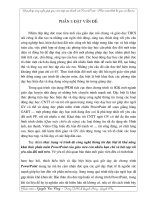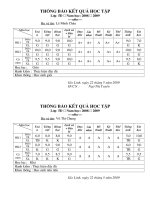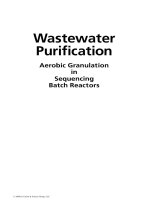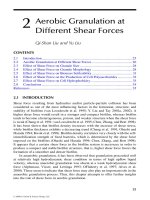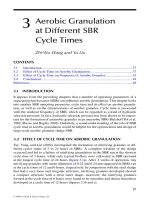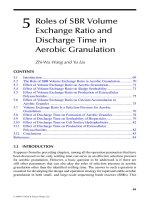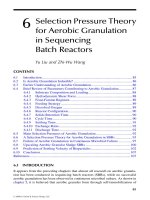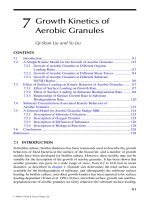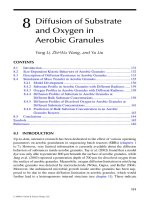5d Semibatch Reactors
Bạn đang xem bản rút gọn của tài liệu. Xem và tải ngay bản đầy đủ của tài liệu tại đây (2.43 MB, 28 trang )
<span class='text_page_counter'>(1)</span>Lecture 5d Chemical Reaction Engineering (CRE) is the field that studies the rates and mechanisms of chemical reactions and the design of the reactors in which they take place..
<span class='text_page_counter'>(2)</span> Lecture 10 – Tuesday 2/12/2013 . 2. Block 1: Block 2: Block 3: Block 4:. Mole Balances Rate Laws Stoichiometry Combine.
<span class='text_page_counter'>(3)</span> Selectivity in Multiple Reactions. Selectivity. 3. Yield. Instantaneous. SD/U = rD/rU. YD = rD / − rA. Overall. ŜD/U = FD/FU. YˆD = FD /( FA0 − FA ). Keep CA high and CB low..
<span class='text_page_counter'>(4)</span> Semibatch Reactors Semibatch reactors can be very effective in. maximizing selectivity in liquid phase reactions. The reactant that starts in the reactor is always the limiting reactant.. 4.
<span class='text_page_counter'>(5)</span> Semibatch Reactors Semibatch reactors A+B→C+D. Liquid level and volume increase 5.
<span class='text_page_counter'>(6)</span> Semibatch Reactors 1) Mass Balance:. dm = m dt m = 0 0. dV = 0 dt t = 0 V = V0 6. and. m = V 0.
<span class='text_page_counter'>(7)</span> Semibatch Reactors 1) Mole Balance on Species A: [in] – [out] + [gen] = [acc]. dN 0 − 0 + r AV = dt. dV = 0 dt 7. A.
<span class='text_page_counter'>(8)</span> Semibatch Reactors 1) Mole Balance on Species B:. dN B FB 0 − 0 + rBV = dt. FB 0 = C B 0 0. 8. dV = 0 dt. ( C B 0 − C B ) 0 dC B = rB + dt V.
<span class='text_page_counter'>(9)</span> Semibatch Reactors 1) Mass and Mole Balance Summary. (1) (2) (3) (4) 9. (5). 0C A dC A = rA − dt V 0 (C B 0 − C B ) dC B = rB + dt V dCC 0CC = rC − dt V 0C D dC D = rD − dt V V = V0 + 0t.
<span class='text_page_counter'>(10)</span> Semibatch Reactors 2) Rate Laws 3) Stoichiometry. 10. 4) Parameters. − rA − rB rC rD = = = 1 1 1 1. (8). rC = −rA. (9). rD = −rA. (10). N A0 − N A X= N A0. (12). N A = C AV. C A0 , V0 , 0 , k , C B 0.
<span class='text_page_counter'>(11)</span> Semibatch Reactors. 11.
<span class='text_page_counter'>(12)</span> Semibatch Reactors. 12.
<span class='text_page_counter'>(13)</span> Equilibrium Conversion in Semibatch Reactors with Reversible Reactions Consider the following reaction:. Everything is the same as for the irreversible case, except for the rate law:. 13.
<span class='text_page_counter'>(14)</span> Equilibrium Conversion in Semibatch Reactors with Reversible Reactions Where:. N A0 (1 − X ) V ( FB 0t − N A0 X ) C B= V C A=. At equilibrium, − rA = 0 then. Xe changes with time. 14.
<span class='text_page_counter'>(15)</span> P6-6B - Semibatch Reactors Sodium Bicarbonate + Ethylene Chlorohydrin → Ethylene Glycol + NaCl + CO2↑. 15.
<span class='text_page_counter'>(16)</span> P6-6B - Semibatch Reactors Semibatch Reactors in terms of Moles Mole Balances. A B C D CO2. dN a (1) = rAV dt dN b (2) = FB 0 + rBV dt dN c (3) = rCV dt (4) N D = N C 0 = − FCO2 + rCO2V (5). 16. Stoichiometry. FCO2 = rCO2V − rA = −rB = rC =r D = rCO2.
<span class='text_page_counter'>(17)</span> (6) (7 ) (8) (9). Rate Laws. 17. dV = 0 − CO2 dt FCO2 MWCO2 CO2 = RHO MW = 44 RHO = 1000. (10) Ca = N A V (11) C B = N B V (12) rA = −kC AC B N a0 − N a (13) X = N a0 (14) N a 0 = V0Ca 0.
<span class='text_page_counter'>(18)</span> P6-6 Semibatch: Moles, Na, Nb, etc..
<span class='text_page_counter'>(19)</span> 19.
<span class='text_page_counter'>(20)</span> 20.
<span class='text_page_counter'>(21)</span> 21.
<span class='text_page_counter'>(22)</span> P6-6 Semibatch: Concentrations CA, CB, CC.
<span class='text_page_counter'>(23)</span> 23.
<span class='text_page_counter'>(24)</span> 24.
<span class='text_page_counter'>(25)</span> Semibatch Reactors Three Forms of the Mole Balances applied to Semibatch Reactors:. 1. Molar Basis. 3. Conversion 25. dN A = rAV dt dN B = FB 0 + rBV dt. dX − rAV = dt N A0.
<span class='text_page_counter'>(26)</span> Semibatch Reactors Consider the following elementary reaction: A+B C+D -rA=kCACB The combined Mole Balance, Rate Law, and Stoichiometry may be written in terms of number of moles, conversion, and/or concentration: Conversion This image cannot currently be displayed.. 26. Concentration. No. of Moles dN A = rAV dt dN B = FA0 + rBV dt.
<span class='text_page_counter'>(27)</span> Polymath Equations. 27.
<span class='text_page_counter'>(28)</span> End of Lecture 5d. 28.
<span class='text_page_counter'>(29)</span>
